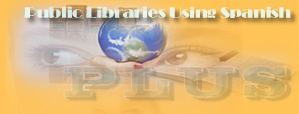|
Cómo navegar la biblioteca
|
Getting Oriented in the
Library
|
|
Ya sabes donde
queda tu biblioteca pública ¿verdad? Si no, abre la guía
telefónica, o pregunta a los vecinos (o a mí, por la
‘dire’ abajo). Hoy nos enfocamos en cómo navegar el mundo
de la biblioteca. Yo seré tu brújula. |
By now you know where your local public library is, right?
If not, open the phone book, or ask your neighbors (or me,
at the address below). Today we'll focus on how to
navigate the library itself. I'll be your compass. |
|
Primero, pavonea
por la puerta, pero no como cliente sino el mero mero
dueño o la mera mera dueña del lugar. (¡Lo eres, pues!
Igual que yo. ¡Órale, socio!) Que conste que la
biblioteca es un bien comunitario que respaldamos mediante
nuestros impuestos. El compartir es virtuoso, pero
compartir implica aprovecharse en el acto…de otra manera
no estés compartiendo sino rendiéndote ¿qué no? |
First, stride right through
the door, and not like a customer but instead just like
you own the place. (You do! So do I!
Hey, partner!) Keep in mind that the library is a
shared community resource that we support with our taxes.
Sharing is a virtue, but sharing implies getting your own
fair share...otherwise you're not really sharing but
yielding, see? |
|
¿Qué verás dentro
de la biblioteca? Cúmulo sin forma…libros, estantes,
computadoras...si te mareas, es normal. Tu primera
pregunta será ¿dónde estará lo que necesito en este lío?
Piensa en un supermercado. Empiezas con una lista de
las compras necesarias, luego te paseas de arriba abajo,
medio perdido, y llenas la carreta. |
What will you see inside the library? A big
shapeless mass of books, shelves, computers...if you feel
woozy at first, that's normal. Your first question's
going to be, Where am I gonna find what I need in this
mess? Think about a new supermarket. You
start with your shopping list, and you walk up and down
the aisles, sort of lost, and you fill your cart. |
|
Es distinta la
biblioteca, nuestro Supermercado de Conocimiento con
gangas inagotables. Tiene la ventaja de una ordenación
lógica. Así no hay que perder tiempo vagando. |
It's different at the library, our Supermarket of
Knowledge with non-stop bargains. It has the
advantage of logical organization. So there's no
need to waste time wandering up and down the aisles. |
|
El código en el
lomo de cada libro sirve como el número de una casa. Es la
‘dirección’ del libro. Lógico que cuando sabemos sus señas,
hallamos el libro en seguida si entendemos el terreno. |
The labels on the spines of the books are like the numbers
of houses and apartments. That code is the book's
"address." So you can see that when we know its
particulars, we find the book in a snap if we understand
the neighborhood. |
|
En bibliotecas
estadounidenses, libros en español típicamente ocupan un
barrio aparte. No por discriminación de vivienda; nomás
nos conviene así. Pero aún dentro del barrio chico (o no
tan chico: la biblioteca central de Los Angeles tiene un
salón enorme colmado por el idioma de Cervantes), hay
arreglo. Las novelas por aquí, ordenadas según los nombres
de sus autores; libros verídicos por allá, agrupados por
tema y con su número correspondiente (recetas, 641;
deportes, 796…) La sección de libros infantiles en español
sigue las mismas pautas. |
In U.S. libraries, books in Spanish typically live in
their own barrio. Not because of redlining;
it's simply more convenient that way. But even
within that little neighborhood (or not so little: the
Central Library of Los Angeles has a huge room spilling
over with the language of Cervantes), there is order.
Novels over here, arranged according to the names of the
authors; nonfiction books over there, grouped by topic and
with their corresponding numbers (cookbooks, 641; sports,
796...) The children's books in Spanish follow the
same guidelines. |
|
Son estantes de
acceso libre donde podemos toparnos con deleites
inesperados—como en el supermercado, pero nada de caro.
También la computadora hogareña fácilmente puede afinar la
búsqueda de materiales y efectuar su entrega—online
shopping ¡sin costo! Esto explicaremos en la próxima
visita. ¡Nos vemos en las estanterías! |
We're talking about open-access shelves where we can
stumble over unexpected delights—kind
of like in the supermarket, but it doesn't cost anything.
And your home computer can help you focus your search for
materials and arrange their delivery—online shopping, for
free! We'll explain that in our next visit.
See you in the stacks! |
|
Si quieres
saber más del ordenamiento de libros, vé el Sistema Dewey
en español: http://www.sol-plus.net/plus/ddc/00.htm
Dirige tus preguntas
sobre cualquier tema bibliotecario a
flaco@sol-plus.net
|
If you want to learn more about the way the library
classifies books, have a look at the Dewey Decimal System
in Spanish: http://www.sol-plus.net/plus/ddc/00.htm
Send your questions about libraries to flaco@sol-plus.net |



